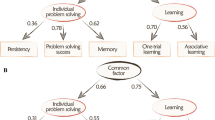Abstract
The transfer index (TI) is a discrimination reversal paradigm that requires the achievement of a given prereversal criterion of accuracy. The mediational learning (ML) paradigm is a modification of the TI procedure that features the presentation of three different reversal conditions designed to assess whether prereversal learning is based on purely associative processes or mediated by the use of a strategy (win-stay/lose-shift). These two paradigms have been used with apes and several Old World monkey species, proving to be effective tools for the comparison of species on the basis of their transfer abilities and the nature of their learning processes. However, among New World monkeys, only the squirrel monkey has been tested. Capuchin (Cebusspp.) adaptability and their mastery in using tools have led to controversial interpretations of their cognitive and learning skills. We evaluated their mode of learning and the transfer of learning using the TI and the ML paradigms. We tested four tufted capuchins (Cebus apella)in a WGTA using a variety of stimulus object pairs. The results show that they possess rather good transfer abilities and one subject showed an associative learning mode. None of the subjects showed evidence of learning mediated by a win-stay/lose-shift strategy.
Similar content being viewed by others
Rererences
Adams-Curtis, L. (1990). Conceptual learning inCebus monkeys.Folia Primatol. 54: 129–137.
Beck, B. B. (1980).Animal Tool Behaviour, Garland Press, New York.
Chevalier-Skolnikoff, S. (1989). Spontaneous tool use and sensorimotor intelligence inCebus compared with other monkeys and apes.Behav. Br. ScL 12: 561–627.
D’Amato, M. R., and Colombo, M. (1988). Representation of serial order in monkeys(Cebus apella).J. Exp. PsychoL Anim. Behav. Process. 14: 131–139.
D’Amato, M. R., and Salmon D. P. (1984). Cognitive Processes in Cebus Monkeys. In Roitblat, L., Bever, T. G., and Terrace, S. (eds.),Animal Cognition, Lawrence Erlbaum Associates, Hillsdale, NJ, pp. 149–164.
D’Amato, M. R., Salmon, D. P., Loukas, E., and Tomie A. (1985a). Symmetry and transitivity of conditional relations in monkeys(Cebus apella) and pigeons(Columba livia).J. Exp. Anal Behav. 44: 35–47.
D’Amato, M. R., Salmon, D. P., and Colombo, M. (1985b). Extent and limits of the matching concept in monkeys(Cebus apella).J. Exp. Psychol. Anim. Behav. Process. 11: 35–51.
D’Amato, M. R., Salmon, D. P., Loukas, E., and Tomie, A. (1986). Processing of identity and conditional relations in monkeys(Cebus apella) and pigeons(Columba livia).Anim. Learn. Behav. 14: 365–373.
Essock, S. M., and Rumbaugh, D. M. (1978). Development and measurement of cognitive capabilities in captive nonhuman primates. In Markowitz, M., and Stevens, V. J. (eds.),Behaviour of Captive Wild Animals, Nelson-Hall, Chicago, pp. 161–208.
Essock-Vitale, S. M. (1978). Comparison of ape and monkey modes of problem solution.J. Comp. Physiol. Psychol. 92: 942–957.
Fellows, B. J. (1967). Chance stimulus sequences for discrimination tasks.Psychol. Bull. 67: 87–92.
Fragaszy, D. M., and Adams-Curtis, L. E. (1991a). Generative aspects of manipulation in tufted capuchin monkeys(Cebus apella), J. Comp. Psychol. 105: 387–397.
Fragaszy, D. M., and Adams-Curtis, L. E. (1991b). Environmental challenges in groups of capuchins. In Box, H. O. (ed.),Primate Responses to Environmental Change, Chapman and Hall, London, pp. 239–264.
Fragaszy, D. M., Visalberghi, E., and Robinson, J. G. (1990). Variability and adaptability in the genusCebus.Folia Primatol. 54: 114–118.
Goodall, J. (1986).The Chimpanzees of Combe, Bclknap Press of Harvard University Press, Cambridge, MA.
Harlow, H. F. (1949). The formation of learning sets.Psychol. Rev. 56: 51–65.
Hull, C. L. (1943).Principles of Behaviour, Appleton-Ccnlury-Croft, New York.
Koehler, W. (1927).The Mentality of Apes, Roulledge and Kegan Paul, London.
Levine, M. A. (1959). A model of hypothesis behaviour in discrimination learning set.Psychol. Rev. 66: 353–366.
Levine, M. A. (1970). Human discrimination learning: The subset-sampling assumption.PsychoL Bull. 74: 397–404.
Natale, F., and Antinucci, F. (1989). Stage 6 object-concept and representation. In Antinucci, F. (ed.),Cognitive Structure and Development in Nonhuman Primates, Lawrence Erlbaum Associates, Hillsdale, NJ, pp. 97–112.
Rumbaugh, D. M. (1969). The transfer index: An alternative measure of learning set. InProceedings of the 2nd International Primalological Society Congress, Karger, Basel, pp. 267–272.
Rumbaugh, D. M. (1970). Learning skills of anthropoids. In Rosemblum, L. A. (ed.),Primate Behaviour: Developments in Field and Laboratory Research, Vol. 1, Academic Press, New York, pp. 1–70.
Rumbaugh, D. M. (1971). Evidence of qualitative differences in learning processes among primates.J. Comp. Physiol. Psychol. 76: 250–255.
Rumbaugh, D. M., and Gill, T. V. (1973). The learning skills of great apes.J. Hum. Evol. 2: 171–179.
Rumbaugh, D. M., and Pate, J. L. (1984). The evolution of cognition in primates:A comparative perspective. In Roitblat, L., Bever, T. G., and Terrace S., (eds.),Animal Cognition, Lawrence Erlbaum Associates, Hillsdale, NJ, pp. 569–587.
Schino, G., Spinozzi, G., and Berlinguer, L. (1990). Object concept and mental representation inCebus apella andMacaca fascicularis.Primates 31(4): 537–544.
Spence, K. W. (1937). The nature of discrimination learning in animals.PsychoL Rev. 43: 427–449.
Visalberghi, E. (1989). Primate tool use: Parsimonious explanations make better science. Comment to Chevalier-Skolnikoff S., Spontaneous tool use and sensorimotor intelligence inCebus compared with other monkeys and apes.Behav. Br. Sci. 12: 608–609.
Visalberghi, E. (1990). Tool use inCebus.Folia Primatol. 54: 146–154.
Visalberghi, E. (1992). Tool use in a South American monkey species. An overview of characteristics and limits of tool use inCebus apella. In Bertheleb, A., and Chavaillon, J. (eds.),The use of tools by Human and Non-Human Primates, Oxford University Press, Oxford, pp. 118–131.
Washburn, D. A., and Rumbaugh, D. M. (1991). Rhesus monkey(Macaca mulatto) complex learning skills reassessed.Int. J. Primatol 12: 377–388.
Westergaard, G. C, and Fragaszy, D. M. (1985). Effects of manipulatable objects on the activity of captive capuchin monkeys(Cebus apella).Zoo Biol. 4: 317–327.
Wolfheim, J. (1983).Primates of the World. Distribution Abundance and Conservation, University of Washington Press, Seattle.
Author information
Authors and Affiliations
Rights and permissions
About this article
Cite this article
De Lillo, C., Visalberghi, E. Transfer index and mediational learning in tufted capuchins (Cebus apella). Int J Primatol 15, 275–287 (1994). https://doi.org/10.1007/BF02735277
Received:
Accepted:
Issue Date:
DOI: https://doi.org/10.1007/BF02735277




